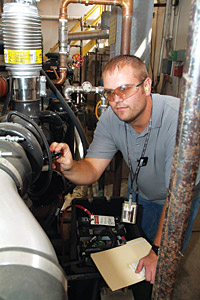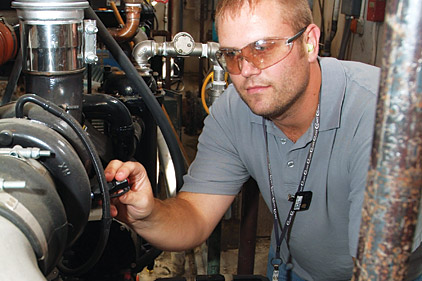
|
| The Department of Energy (DOE) has begun the process of developing efficiency standards for clean-water commercial and industrial pumps. The DOE is accepting industry comments through May 2. |
For the first time, the U.S. Department of Energy (DOE) is considering creating minimum efficiency standards for clean-water commercial and industrial pumps — and they’re calling on industry leaders, manufacturers, industry associations, and other organizations for input.
And though it may be several years before any new laws are put on the books, the process is officially underway — a process some believe is long overdue.
Gathering Input
While the U.S. has been a leader in many energy-saving initiatives, it lags far behind Europe when it comes to regulating the energy efficiency of commercial and industrial pumps. Even though the DOE has had the authority to regulate pumps since the 1990s, it was not until January that it released its 134-page energy conservation standards rulemaking framework document for the equipment.
Want more HVAC industry news and information? Join The NEWS on Facebook, Twitter, and LinkedIn today!
The literature describes the procedural and analytical approaches the DOE will likely use to evaluate potential new energy conservation standards for pumps while also soliciting input from interested parties during the rulemaking process. An examination of the document reveals that the DOE will likely model pump efficiency standards after those currently in place in Europe.
“The release of the framework document for comment is the first of many steps in the standards rulemaking process,” said Charlie McCrudden, vice president for government relations, Air Conditioning Contractors of America (ACCA). “Stakeholders will have more opportunities to review any proposed standards and comment on them.”
“They have a pretty clear and transparent process by which they work with the market to learn more about a product, how it fits in the market, and what’s out there as far as existing test procedures. Then, they work with those in the market to develop or modify an existing test procedure,” said Greg Towsley, director of regulatory and technical affairs for Denmark-based pump manufacturer Grundfos. “Finally, they come up with their efficiency rule.”
Towsley added. “The process can be somewhat long, but it’s in the favor of the market to do it that way to make sure a proper analysis occurs.”
Steve Thompson, director of residential product management for Cranston, R.I.-based Taco Inc., agreed that the process for developing new standards is no small undertaking. Thompson, who serves as the chair of the Fluid Pumps committee of the Air-Conditioning, Heating & Refrigeration Institute (AHRI), said AHRI and the Hydraulic Institute (HI) are actively working with the DOE as it moves toward developing these new standards.
“AHRI has supported the HI’s recommendation to the DOE that they go forward in parallel with the European pump standards with the understanding that the proper conversions are followed,” Thompson said. “When the law is made, we will probably have until 2019 to actually upgrade our products and comply with the law, so there is a six- or seven-year window for manufacturers.”
Currently, the DOE is accepting input on pump efficiency standards from any interested parties. Comments must be submitted by May 2 (see sidebar).
Huge Energy Savings
Industry leaders estimate that 20 percent or more of the electricity used in the U.S. is consumed by pumps alone. If efficiency standards are implemented for clean-water commercial and industrial pumps, the energy savings could be significant.
“That’s an enormous amount of electricity,” said Jes Munk Hansen, CEO, Grundfos. “Can you imagine if we could take out just 4 or 5 percent of that? You can do some math and calculate how many coal plants that is. It’s dramatic.”
“We are energy hogs,” Thompson agreed. “There are estimates that the power used to heat and cool buildings is 40 percent of the electrical demand, so if we could cut that by 10 percent, which we should be able to do, this affects a lot of other things. You won’t have to build as many power plants or upgrade power grids.”
Hansen said many pumps in use today “run full-time, all the time, which is completely silly, because half the time you don’t need the pump to run.” He added, “It’s estimated that most pumps only need to run full-speed 5 percent of the time.”
Those pumps are not only a drain on the electrical grid, he said, but they are also driving up utility costs for building owners.
“Building owners, particularly large building owners — hotel chains or grocery stores, for example — are getting very, very attentive to their utility bills, both for branding reasons and for cost savings,” Hansen said. “Sure, legislation would catapult this into something new. This is long overdue.”
Grundfos president Dennis Wierzbicki agreed with Hansen. “I think building owners need it,” he said. “We can’t keep building power plants in this country; we have to look at ways to reduce energy consumption, and I think the current administration is convinced of it.”
Support from Manufacturers
Pump manufacturers across the country have begun to embrace energy-saving technology, including electronically commutated motors, which allow pumps to operate at varying speeds. Electronics and software that allow users to more accurately control and even wirelessly monitor pumps are also growing in popularity. The degree to which different manufacturers have embraced and developed that technology, however, differs between manufacturers.
Hansen said Grundfos, which already faces strict pump-efficiency standards in Europe, fully supports implementing efficiency standards for commercial and industrial clean-water pumps in the U.S.
“We are convinced this is necessary, and we know the DOE is taking actions now in the U.S.,” Hansen said. “This will come to be in this country because the energy consumption related to pumps is so enormous.”
Taco also supports setting minimum efficiency standards for the pumps. “At the end of the day, it’s probably a good thing for the U.S. marketplace,” Thompson said. “It will substantially reduce the amount of power being used.”
“I think, regardless of legislation, we would have done this,” Hansen added. “Let’s say these laws don’t come. We will continue on that path because this is not just legislation. This is an old-fashioned industry that’s skating away from technology.”
“It will make everybody accountable, and that’s a good thing,” Thompson said. “It would also shield us from some imports that are sub-quality and help promote products made in the U.S.”
Advancing the Industry
In addition to saving energy, new pump efficiency standards would also set a uniform bar for manufacturers to meet and exceed. That could lead to a more competitive environment, which could be beneficial to the industry.
“We relish an even playing field,” Thompson said. “We’re quite conscious about making sure our pumps perform to our performance curves. Unfortunately, not all pump manufacturers are that conscious.”
Towsley said tougher standards could also encourage new product development. “I think it will be a good challenge to manufacturers in that it will force them to take these steps to create more innovative products, which they may or may not have been considering in the past,” he said. “It’ll raise the bar on efficiency and technology to reduce energy.”
“We’ll all manufacture whatever the DOE regulates, because we’ll be forced to,” Thompson agreed, adding, “At Taco, we’re a responsible, reputable company that has been around for 100 years. We’re going to do whatever it takes to get things done.”
“If we don’t get up on that level of technology, then we’ll get flooded in a few years with products that we simply can’t compete against,” Hansen said. “Even if there’s no legislation, even if the customers don’t want it in the next two or three years, we simply need to do it because five or six years from now, there will be systems coming in that are 10 or 15 years ahead of us. That’s a situation we shouldn’t get in.
“Let’s lift up the bar for all of us, force us all to innovate and compete — not on cast-iron products from the 1940s and 1950s, but on software and electronics integration,” Hansen continued. “That’s what we really need to do.”
The Contractor’s Role
Though pump efficiency standards would affect manufacturers to varying degrees, contractors will likely only have to make minor adjustments to adapt to installing and servicing higher-efficiency pumps. Dan Foley, owner of Foley Mechanical Inc., Lorton, Va., said new pump efficiency standards could affect the installation process more than anything else.
“It might change how we handle installations, but it’s more on the design and application phase,” explained Foley, whose company specializes in high-end custom residential HVAC installations, though they occasionally use commercial pumps on larger projects.
“We have to install whatever the DOE mandates, and manufacturers will have to create products that meet the DOE’s minimum requirements. Therefore it’s going to affect manufacturers more than contractors.”
Technicians may also need additional training to fully understand, install, and service new pumps that are more technologically advanced than what they’re currently working with. Foley said this will not be a burden on his workers, who continually train to keep up with new technology, though he said it could be problematic for some contractors.
“I believe in using high-efficiency equipment, but if left to its own devices, the contractor community is going to use what’s on the shelf, or what they can sell,” Foley explained. “These guys have to know what they’re doing. You can’t be stupid. Technology is raising the level of service in the field. Either you learn this stuff, or you get left behind.”
For more information, visit the Department of Energy's website.
Submitting a Comment to DOE
According to the U.S. Department of Energy (DOE), comments may be submitted through www.regulations.gov, via email, by postal mail, or by hand delivery/courier. All comments must be received by May 2. Any comments submitted must identify the commercial and industrial pumps energy conservation standards rulemaking by name and provide its docket number EERE-2011-BT-STD-0031 and/or Regulation Identifier Number (RIN) 1904-AC54. Comments may be submitted using any of the following methods:
• Federal e-Rulemaking Portal: The rulemaking docket is located at www.regulations.gov. Follow the instructions for submitting comments.
• Email: Pumps2011STD0031@ee.doe.gov. Include the docket number and/or RIN in the subject line of the message.
• Mail: Ms. Brenda Edwards, U.S. Department of Energy, Building Technologies Program, Mailstop EE–2J, 1000 Independence Ave., SW, Washington, DC 20585-0121. Please submit one signed original paper copy.
• Hand Delivery/Courier: Ms. Brenda Edwards, U.S. Department of Energy, Building Technologies Program, 950 L’Enfant Plaza, SW., Ste. 600, Washington, D.C., 20024. Telephone: (202) 586-2945. Please submit one signed original paper copy.
Publication date: 4/22/2013



Report Abusive Comment